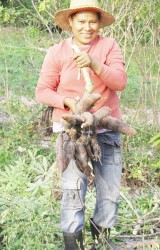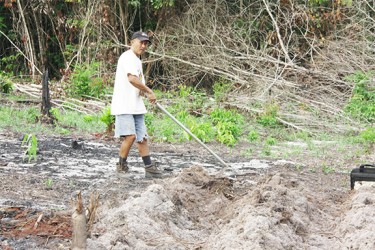We met Marcia Gonsalves last Friday at a forum on agro-processing at the International Conference Centre organized by the Guyana Marketing Corporation. She was one of probably a dozen or so exhibitors who had mounted product displays in the foyer of the Conference Centre. Agro processing is still to make a really meaningful footprint on the Guyana economy. The sector is almost entirely dominated by small operators and there are numerous obstacles to their growth.
Given the rarity of such opportunities, last Friday’s event could have been more interactive. Stabroek Business had been assured that the event would allow for meaningful exchanges amongst the stakeholders in the sector. As it turned out there were far too many lengthy presentations and the setting did not allow for the sorts of exchanges which one felt could have yielded a great deal in the way of fruitful outcomes.
The really interesting exchanges took place during the breaks, in the corridors and the foyer where the real discussions were ensuing on issues like the high cost of electricity, access to financing, reticence among commercial banks about ‘doing business’ with small agro processors and the additional costs of bottling and labelling products.

Marcia is one of the growing numbers of agro-processors across the country whose progress is slow. She is a determined-looking woman from Region One and the mother of two children. After she had moved to the coast and been, first, a teacher at a private school and, subsequently a stay-home mother, she ventured into agro processing.
It had started with a gift of six bags of bitter cassava from a relative. There had been teething problems like the storage of products. More than that she had known very little about planting. Mr. Kwang had been a great help, giving advice on planting methods and pressing his chain saw into service to assist Marcia with land-clearing.
These days, her challenges are similar to those of many other small agro-processors, the primary one being a scarcity of funds. All of the various other challenges, or at least most of them, derive from insufficient access to money.

We decided to visit Marcia at Sillion Green on the Soesdyke-Linden Highway to get a better sense of the nature of her enterprise and what it had taken to keep her going these past two years. Marcia’s Products, the trading name of her enterprise, manufactures Casareep, Farine and Cassava Bread, not at Sillion Green but at her home at Soesdyke. It is, like so many other local agro-processing ventures a ‘kitchen operation.’ Most operators in the sector are still some distance away from acquiring even some of the relatively inexpensive machinery used in the various manufacturing processes.
There was a particular reason for Marcia’s invitation to us to visit her at Sillion Green. Cassava is the primary input for all of her products and her current pet peeve is the unreliability of her suppliers, the continually declining quality of the cassava available on the market and rising prices. She had decided to do something about the cassava problem and the purpose of her invitation to us to come to Sillion Green was to witness the reaping of cassava she had planted there.
The cassava plot is about an acre and a half of a giant spread of about 50 acres owned by another family, the Da Silvas. Sillion Green is about twenty five minutes’ drive from the Linden/ Soesdyke Junction. Getting to the farm takes a further fifteen minutes. Marcia’s own market ‘survey’ tells her that there is a demand for cassava bread, but that meaningful profits can only come from large scale production. Her lack of control over both price and supplies of bitter cassava had long impacted negatively on the growth of her enterprise and she had been contemplating how to break that stranglehold.
Some time earlier she had made an application to the Department of Lands and Survey for a plot of land for farming. While she awaits a response she has entered into an arrangement with the Da Silvas to cultivate a plot on their spread.
Over a two-year period the price of bitter cassava has increased from fifteen dollars a pound to about forty dollars a pound. That apart, the quality of the cassava supplies had grown progressively worse.
On Saturday we watched Marcia harvest her own cassava for the first time. She was satisfied though not elated with the yield. She had reaped about sixty pounds of usable cassava. A larger quantity was decimated by ants. She now has to go in search of a solution.
The ants had appeared over the past nine months and were devouring the cassava leaves. We spoke about the decimated cassava and she said that when she had seen it for the first time it had brought her close to tears.
There are other impediments to Marcia’s efforts to cultivate cassava. The nearby creek is inaccessible because of the dense vegetation. Up to now she has been relying on rain. She’d like to invest in a water pump but cannot afford it. Her team is herself, her two children and an associate named Mr. Kwang.
Weekdays are spent manufacturing products with the help of a sister and another part-time helper. Sometimes she bakes up to eight hundred pounds of cassava every fortnight. She said that a week ago she had purchased four hundred and fifty pounds of cassava. The purchase had cost her $9,000.00. That amount of cassava, she said, would yield about three hundred and sixty 8-inch cassava bread and thirty 14–inch cassava bread. Additionally, she will have enough cassava left for about two 16 oz bottles of casareep. After her expenses are deducted from this consignment her profit would be around $19,000.00
Cleaning, peeling, washing and milling the cassava is done on Mondays. Sometimes the exercise extends into the early hours of the next day. Sometimes a helper is needed. Marcia has reduced the labour – intensive nature of the exercise by investing in a mill. No grating is needed. Baking is dependent on good weather. Sometimes a single baking exercise takes up to two weeks. On Saturdays she works at the farm.
On Sunday Marcia travelled to the city to attend church at Sacred Heart and we talked some more. We talked about the impediments to the growth of her enterprise. She lists packaging and marketing as her biggest challenges. She purchases bottles from two stores, one on the East Coast and another in Georgetown. Sometimes she secures bottles but no covers and she has to wait.
Competition linked to rising standards has compelled Marcia to invest in tools to render her operation more efficient. In recent times she has invested in a scale, a bottle sealer and a plastic sealer. The three items cost her forty three thousand dollars.
Her major clients include the Bounty Supermarket chain and last week she had a significant breakthrough with Deals Unlimited Supermarket at Soesdyke when the store made its first, modest order of twelve packets of cassava bread, nine pounds of farine and four bottles of casareep.
Currently, Marcia is retailing Casareep at $1500 per 12-oz bottle and $3,000 per 16-oz bottle. Farine, which she produces with technical help from her sister is sold at $360 per pound. Cassava bread is sold at one hundred dollars each.
It takes about nine months for bitter cassava to be ready for reaping. Marcia plants every three months which will enable her to reap cassava throughout the year. Recently, she began cultivating sweet cassava, peppers, pumpkins and sweet potatoes which she will market to subsidize the family income.





